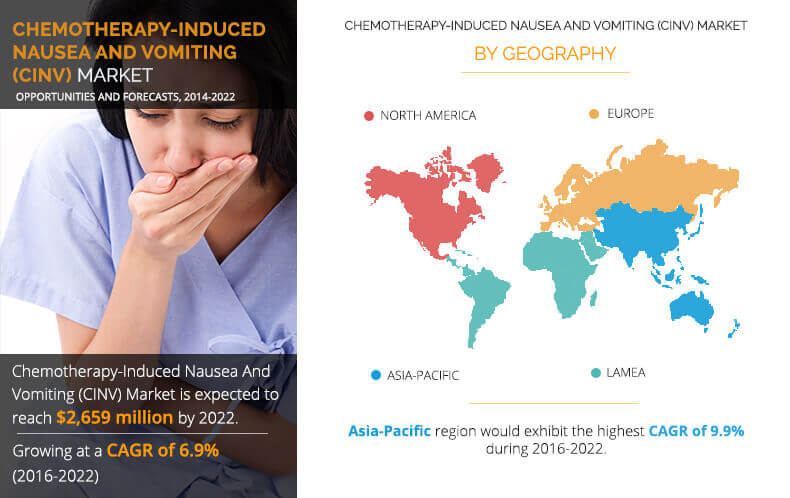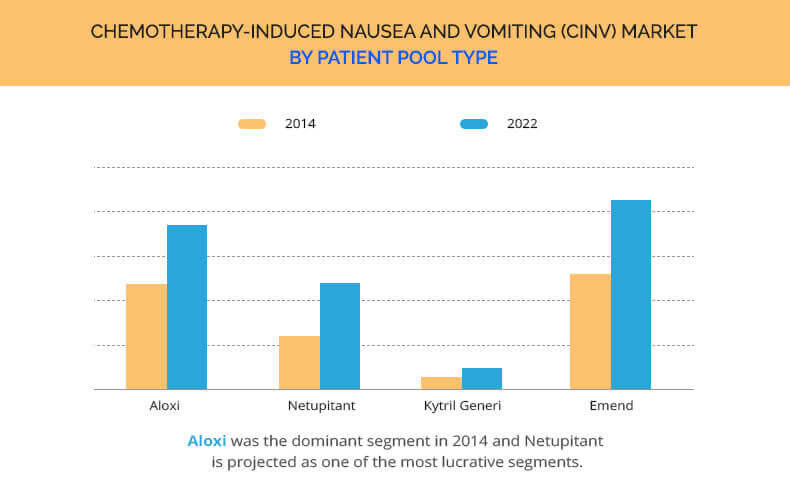Chemotherapy-Induced Nausea and Vomiting (CINV) Market Overview:
The Global Chemotherapy-Induced Nausea And Vomiting (CINV) Market was valued at $1,663 million in 2015, and is estimated to reach $2,659 million by 2022, registering a CAGR of 7.1% during the forecast period 2016-2022.
Nausea and vomiting (emesis) caused by cancer drugs is referred to as chemotherapy-induced nausea and vomiting (CINV). Patient may experience nausea and vomiting within 24 hours (acute) or after 24 hours (delayed) of chemotherapy. Chemotherapy-induced nausea and vomiting leads to the deferment or refusal of therapeutic chemotherapy treatment for cancer. The report analyzes chemotherapy-induced nausea and vomiting (CINV) drugs market based on disease, class, and region.
Segment Review
The global CINV market encompasses patient pool type and geography of the CINV drugs market. The patient pool type segment includes Aloxi (palonosetron), Kytril Generic (Granisetron), Emend (aprepitant), Netupitant-Palonosetron FDC, and others. Netupitant-palonosetron is the fastest growing therapy or drug type for this market owing to increasing adoption to CINV drugs with rising cancer patients going for chemotherapy treatment.
The key impacting factors include growth in number of patients undergoing chemotherapy and the rising compliance to CNIV drugs due to increase in adoption of novel drug delivery methods such as combination therapies & transdermal patches. Further, the market is also influenced by technology developments to discover new high potential drugs, thus creating opportunity for the market growth. However, high price of CINV drugs restrict the growth.
Presently, patient pool segment witnesses a high rate of CINV drugs adoption due to increasing number of patients with side effects associated with chemotherapeutic drug use. Further, the development and launch of novel drug delivery methods for CINV drugs is expected to boost patient compliance rates and the demand for CINV drugs. In addition, improvement in the control of CINV has occurred with the use of aprepitant, the first agent available in the drug class of neurokinin-1 (NK-1). One of the potential factors that explain this suboptimal response is variability in genes encoding enzymes and proteins, which play a role in metabolism, transport, and receptors related to antiemetic drugs.
Based on geography, the market is segmented into North America, Europe, Asia-Pacific, and LAMEA. Asia-Pacific is the fastest growing market at a CAGR of 9.8% owing to the increase in the cancer population and use of chemotherapeutic drugs. Aloxi and Zofran are the key CINV drugs with the largest share and boosting the growth of CINV market in Asia-Pacific during the forecast period 2016-2022. Other driving factors of CINV market in Asia-Pacific are increase in the healthcare spending and health infrastructure.
The key players in the global chemotherapy-induced nausea and vomiting (CINV) drugs are GlaxoSmithKline plc, Helsinn Holding S.A., Heron Therapeutics, Inc., Merck & Co., Inc., and Tesaro, Inc
Key Benefits for Stakeholders
- The study provides in-depth analyses of the CINV market along with the current trends and future estimations to elucidate the imminent investment pockets.
- The report explores the dynamics of the market influencing the adoption and growth of the CINV drugs market
- The report provides a quantitative analysis for the period of 2014-2022 to enable stakeholders to capitalize on the prevailing opportunities in the industry.
- Extensive analysis of the global market helps understand CINV drugs developed and marketed by the key companies.
- Competitive intelligence of market players highlights the business practices and trends across various regions.
Global Chemotherapy-induced Nausea and Vomiting (CINV) Market Report Highlights
| Aspects | Details |
| By PATIENT POOL |
|
| By GEOGRAPHY |
|
| Key Market Players | Merck & Co., Inc, Helsinn Holding S.A., Amneal Pharmaceuticals, GlaxoSmithKline plc, Kyowa Kirin, Inc., Insys Therapeutics, Inc, Acacia Pharma, Heron Therapeutics, Inc., Cadila Pharmaceuticals Limited, Tesaro, Inc. |
Analyst Review
Chemotherapy-induced nausea and vomiting (CINV) drugs market experiences growth due to increase in number of patients undergoing chemotherapy and increased uptake of low toxicity targeted treatments. Some of the key drugs in the market are Akynzeo, Emend, Aloxi, Zofran, Kytril and SUSTOL and Rolapitant. At present, pharmaceutical companies have prioritized investment in R&D of CINV drugs for driving their profit margins and sustain the use of chemotherapeutic drugs.
Granisetron transdermal patch with the trade name Sancuso was approved by the US FDA. It is manufactured by 3M Drug Delivery Systems. Granisetron is a selective inhibitor of type 3 serotonergic (5-HT3) receptors. It has little or no affinity for other serotonin receptors, including 5-HT 1, 5-HT 1A, 5-HT, or 5-HT 2. The cancer population living in the developing economies of LAMEA and Asia-Pacific are adopting novel CINV drug delivery methods such as combination therapies and transdermal patches to minimize the side effects of chemotherapeutic drugs. CINV market in North America generates the largest share of global CINV drugs market, followed by Europe and Asia-Pacific. The demand for CINV drugs market in Asia-Pacific market is expected to post the fastest growth for CINV drugs market.
The key players in the global chemotherapy-induced nausea and vomiting drugs are GlaxoSmithKline plc, Helsinn Holding S.A., Heron Therapeutics, Inc., Merck & Co., Inc., and Tesaro, Inc.
Loading Table Of Content...





